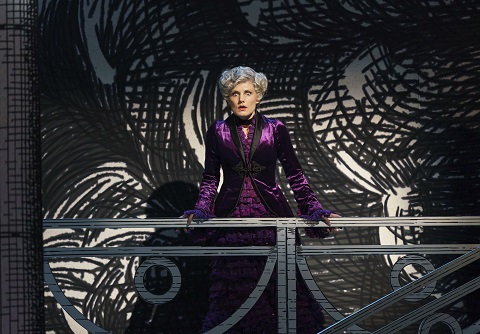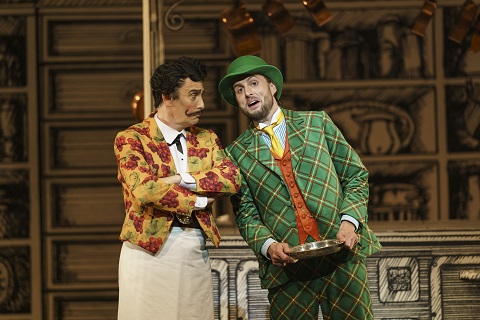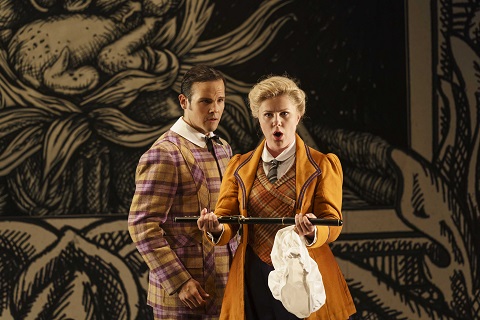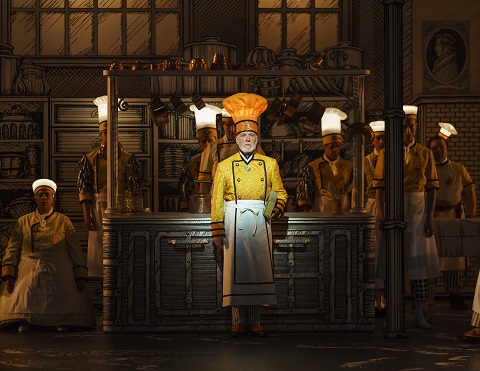After all, when Tamino arrives at Sarastro’s temple on his quest to rescue
Pamina he is instructed by a Priest that Sarastro is not a
daughter-kidnapping tyrant, as the Queen of the Night has declared, but
rather rules by wisdom. Tamino is advised to ignore the words of women who
do little but chatter: a man who believes the wagging tongues of these idle
gossipers is a fool. Later, in Act 2, the Priests again warn against the
treachery of women but the misogyny reaches a peak when Sarastro responds
to Pamina’s desperate pleas to be freed so that she can be re-united with
her mother, “A man must guide your heart, for without him every woman
oversteps her bounds.”
Without going into the ‘history’ of the Queen of the Night’s mission –
considered “arrogant” by Sarastro – to win back the ‘Sun-Circle’ that her
father bequeathed to Sarastro – it seems not unreasonable to argue, as some
scholars do, that ‘the conflict between the realms of light and darkness in
the opera is at its core a gendered conflict’ or that ‘the gender codes of
the opera … reveal a basic sympathy with light or with darkness,
respectively’.
[1]
AndrÈ Barbe and Renaud Doucet, whose new production of Die Zauberflˆte has opened at Glyndebourne, avow a “real
sympathy for the Queen of the Night” whose story they connect to “the
broader theme of women’s rights” and the early 20th-century
suffrage movement. And, the notion of a ‘feminist’ subversion of
Schikaneder’s tale of the journey from feminine darkness to masculine
enlightenment is intriguing. Presumably, one would need to shift the singspiel from its 18th-century context, where,
generally speaking, the masculine = reason (i.e. good) and the feminine =
passion (i.e. bad), and Rousseau’s belief that ‘The search for abstract and
speculative truths … is beyond woman’s grasp’ (Book 5, Emile) was widely held (and accords with Sarastro’s thoughts entirely).
This Barbe and Doucet duly do, setting the drama in an Edwardian hotel,
where Sarastro’s Restaurant serves in place of Temples of Wisdom, Reason
and Nature.
Apparently, research into the Viennese origins of Die Zauberflˆte led Barbe
& Doucet to the Sacher Hotel, situated close to the Vienna State Opera.
Anna Sacher, who became manager after her husband’s death in 1907, acquired
a reputation for eccentricity and economic mismanagement in equal measure,
chain-smoking cigars as she excluded plebeian clientele while pampering to
impoverished aristocrats. From there, the duo made a hospitality hop to
London’s Cavendish Hotel where Rosa Lewis, whose culinary skills had seen
her rise up the society ladder, and entertain American millionaires and
English royalty.
 Caroline Wettergreen (Queen of the Night). Photo credit: Glyndebourne Productions Ltd. Photo: Bill Cooper.
Caroline Wettergreen (Queen of the Night). Photo credit: Glyndebourne Productions Ltd. Photo: Bill Cooper.
Barbe’s beautiful pen-and-ink cloth-drops create a singular locale: a grand
hotel in all its stratified glories and gloominess, from its shady lower
pantries to its sparkling luxury penthouse, by way of the wine cellar,
kitchens and food stores, butler’s office, reception lobby and palm court
conservatory. The designs produce some neat trompe l’oeil effects,
and evoke at times a picture-book fairy-tale, as cardboard cut-out figures
arrive in the lobby or canoodle in the corners of the conservatory.
Conventionally in Die Zauberflˆte, Tamino’s enlightenment
quest is represented as a journey from the subterranean darkness of the
Queen of the Night via purification by fire and water to the heavenly sun
of Sarastro’s masculine rationalism. But, it was Anna Sacher’s husband
Eduard (son of confectioner Franz of Sachertorte fame) who was the
restaurateur, and in their Upstairs-Downstairs domain Barbe & Doucet
invert the norm, making Sarastro head chef overseeing an energetic kitchen
and silver service team, and raising the Queen, via an elegant double
staircase and gleaming baroque balcony, to a top-floor apartment. Yet, it’s
still the women who seem to do all the skivvying, dashing about during the
overture’s fugal busyness armed with towering piles of plates and platters,
cleaning up spillages with new-fangled floor-hoovers, and spic-and-spanning
the kitchen floors in preparation for a pre-service pep talk by Sarastro.
The maids might get a bit edgy when forced to listen to Head Chef’s more
misogynist utterances. And, when Tamino and Papageno are down in the cellar
being prepared for their ritual ordeals, angry, placard-waving suffragettes
race to and fro in the background, pursued by some bobbies-on-the-beat.
But, Barbe & Doucet allow the ‘feminist fury’ to fizzle out and replace
it with games and gimmicks – eye-catching and inventive, no doubt – which
dilute the ‘seriousness’ of their ‘message’.
It’s the eternal conundrum of Die Zauberflˆte: how to balance the
folky, sometimes vulgar, comedy with the high-minded gravity? Having begun
by establishing a ‘concept’ which seems serious in intent, Barbe &
Doucet smother it with spectacle. A pyjamaed-Tamino sleep-walks through the
hotel lobby pursued by an outsize cantilevered centipede, assembled from
assorted crockery. Pillow-puppet birds burst from the bird-catcher’s wicker
chest to dance and dive during Papageno’s first aria, pushing the
bird-catcher himself – an eye-catchingly clad travelling salesman in
emerald green suit and bowler hat with clashing red socks, a veritable
cockerel cock-tail – to the margins. Tamino’s flute-playing doesn’t so much
as charm the wild beasts as reconnects the head and body of a calf that has
been slaughtered by the hotel’s butchery department. Most impressive of
all, the two Armed Men are represented by two 18ft-high puppets: it’s as if War Horse has met Star Wars within Downton Abbey.
 Michael Kraus (Speaker) and Bjˆrn B¸rger (Papageno). Photo credit: Glyndebourne Productions Ltd. Photo: Bill Cooper.
Michael Kraus (Speaker) and Bjˆrn B¸rger (Papageno). Photo credit: Glyndebourne Productions Ltd. Photo: Bill Cooper.
But, it’s not clear what the panoply of puppets are there for …
and the hotpot of culinary motifs keeps bubbling. The three mischievous
‘bell-boys’ enter through the dumb-waiter; the Speaker is a sommelier
wearing a grape-bunch patterned jacket. What of the journey toward
enlightenment – is it to be religious, spiritual, socio-political … or
simply gastronomic, ‡ la Masterchef?
I guess the singspiel’s ‘initiation rituals’ don’t ‘fit’
the Barbe & Doucet concept: after all, Tamino journeys from childhood
to manhood, from feminine darkness to masculine illumination, instructed to
‘be steadfast, patient, and silent’ – all the things women are supposedly
not. After the Three Ladies leave, having tried in vain to convince Tamino
and Papageno to return to the Queen’s fold, the latter smugly sing, “A man
is firm in spirit; he thinks before he speaks.” Que faire? One
can’t simply ditch the opera’s ritual tests of manhood.
Pamina, too, must face trials which align her with the Father and
necessitate a rejection of the Mother. Urging Tamino to play his magic
flute to protect them during their trial by fire and water, Pamina explains
that the flute – a gift to Tamino by his mother – was in fact made by her
father. The directors’ response is to turn the trials into an
irrelevant/irreverent joke; the ordeals borne by Tamino and Papageno are
espied by chuckling hotel staff and marionette-wielding bell-boys: just so
we know who is really pulling the strings.
The playing of the Orchestra of the Age of Enlightenment under Ryan
Wigglesworth rather grinds things down too; there’s plenty of stylishness
and instrumental virtuosity but collectively it feels leaden at times, and
the rather ponderous and portentous overture didn’t get things off to a
good start. The pacing was often ineffective dramatically, though that’s
not necessary Wigglesworth’s fault: how long does it take for the
obsessively punctilious sommelier to pour Papagano a glass of red wine, and
how long should the latter wait for a response to his piped birdcall? Too
long, in both cases, here.
There’s some fine singing to paper over the cracks in the concept, though.
Katharina Magiera’s Third Lady provides a warm and firm foundation for the
feisty trio; Michael Kraus’s Speaker is clear and communicative. Jˆrg
Scheider’s warm singing makes Monostasos a more sympathetic figure than is
often the case. But, his ‘blacked’ face, though the consequence of his
employment as stoker of the hotel’s coal furnace, is a class-related symbol
that aligns him as surely with the Queen – the ‘dark force’ – as his ‘race’
might do. After all, when Sarastro intervenes during Monostasos’s
attempted rape of Pamina, he attacks: “I know that your soul is as black as
your face. And I would punish your black deed with this dagger had not an
evil woman forged the dagger – an evil woman who nevertheless has a
virtuous daughter.” Both vengeful mother and the savage ‘black
slave’ are less than human: Barbe and Doucet’s attempt to break down the
gendered light/dark conflict falls down once more with such oversights.
 David Portillo (Tamino) and Sofia Fomina (Pamina). Photo credit: Glyndebourne Productions Ltd. Photo: Bill Cooper.
David Portillo (Tamino) and Sofia Fomina (Pamina). Photo credit: Glyndebourne Productions Ltd. Photo: Bill Cooper.
As Tamino, David Portillo – swapping his stripy bedwear for a tweed jacket
and breeches – sails the crest of his melodic lines with strength and his
tone is true. Sofia Fomina’s Pamina initially sounded a little too ‘mature’
for my liking, but she later radiated sincerity in her duet with Papageno
and when humbly beseeching Sarastro. ‘Ach ich fuhl’s’ was a bit choppy
though, as rubatos, ornaments and a slight vocal wobble disrupted the line.
When her suicidal thoughts are thwarted by the Three Boys, Fomina is
required to costume-swap mid-aria, her gown ditched for boots and breeches,
her modesty protected by white sheets held decorously in place by the Boys.
Given that the quartet then dash from the stage, why couldn’t the change of
attire wait? It was hardly meaningful action or in service of the music.
I admired Caroline Wettergreen’s performance as the Fairy in Fiona Shaw’s
Cendrillon
during last autumn’s Glyndebourne Tour, but here her Queen of the Night was
less impressive – though the audience were vigorously receptive. There’s no
doubt that Wettergreen can hit the high notes, and she relishes them –
sometimes for too long and too often: the decision to take the final
cadence of ‘O zittre nicht’ up an octave was a mistake, especially as the
preceding aria had not been exactly ear-soothing. Similarly, the peaks of
‘Der Hˆlle Rache’ punched powerfully but the intonation elsewhere in the
aria was often painfully adrift.
Bjˆrn B¸rger’s Papageno is a joy – just as was his Figaro in Glyndebourne’s
2016
Il barbiere
–
though his natural stage exuberance is sometimes hampered by the conceptual
clutter. Thank goodness for Brindley Sherratt’s wonderfully ‘human’
Sarastro: he resonated intellect, thoughtfulness and real feeling, even if
the High Chef’s dignity was somewhat diminished by his glowing orange toque
– which presumably was supposed to represent the sun, but which in the
gloomy kitchen often resembled a pedestrian crossing light, surrounded by
the street-lamp white bulbs of his kitchen underlings. Moreover, ‘In diesen
heil’gen Hallen’ was unforgivingly disrupted by, first, a shadow-play
intrigue between the Queen and the exiled Monostasos, and then, the
dropping of the front-curtain so that Pamina and Sarastro found themselves
standing in the street outside the hotel restaurant while a noisy scene
change was effected behind them.
 Brindley Sherratt (Sarastro). Photo credit: Glyndebourne Productions Ltd. Photo: Bill Cooper.
Brindley Sherratt (Sarastro). Photo credit: Glyndebourne Productions Ltd. Photo: Bill Cooper.
Given the rifts in the conceptual reasoning and execution, Barbe and Doucet
don’t really seem to know how to bring proceedings to a close. Puppetry
becomes crudity when Papageno finally wins his Papagena and, after some
vigorous humping behind the kitchen range, his female companion’s vastly
inflated ‘legs’ are hoisted over the counter-top, the range door is opened
and the phrase ‘a bun in the oven’ assumes a grotesque manifestation as a
multitude of Papageno/as is blasted from the furnace, sent flying to a
kitchen worktop where the puppets are decapitated and dance a ghastly
goofing, gooning galop. So much for wedded bliss.
As for our plucky duo who have endured fire and ice, Pamina decides that
she’s going to grab the flute and call the tunes, while Tamino is
despatched to complete the household chores: we see him drying dishes
through a transparency of a fruit-and-veg head ‡ la Arcimboldo.
Meanwhile, the Queen and her dark knights infiltrate the wine cellar, only
to be drowned by the upswelling of a sudden storm. We assume she has fallen
into eternal darkness, but when Sarastro calls the enlightened together for
a slap-up supper around the chef’s top table it seems that darkness has not
been dispelled for the resurrected Queen is welcomed into the fold with a
glass of Ch‚teau Lafite.
Pamina has been admitted into the ‘temple’ for she has learned to accept,
of her own free will, that the Father is superior to the Mother, and she
will conform to the role required of her. The return of the Queen of the
Night at this point seems to reinforce the resolution of opera in terms of
the acceptance of a femininity within the male realms of wisdom and
nobility as complementary to the masculine, as long as it is subordinate
within the gender hierarchy.
Just how feminist is that?
Claire Seymour
Tamino – David Portillo, First Lady – Esther Dierkes, Second Lady – Marta
Fontanals-Simmons, Third Lady – Katharina Magiera, Papageno – Bjˆrn B¸rger,
Queen of the Night – Caroline Wettergreen, Monostatos – Jˆrg Schneider,
Pamina – Sofia Fomina, Speaker – Michael Kraus, Sarastro – Brindley
Sherratt, Second Priest and First Man in Armour – Thomas Atkins, First
Priest and Second Man in Armour – Martin Snell, Papagena – Alison Rose,
Puppeteers – Richard Booth, Mikey Brett, Ashleigh Cheadle, Jack Parker, Ben
Thompson, Scarlet Wilderink, Three Boys – Daniel Todd, Simeon Wren, Felix
Barry-Casademunt; Direction and Design – Barbe & Doucet, Conductor –
Ryan Wigglesworth, Puppet Designer – Patrick Martel, Lighting Designer –
Guy Simard, Orchestra of the Age of Enlightenment, The Glyndebourne Chorus.
Glyndebourne, Thursday 18th July 2019.
[1]
Stuckey, Priscilla. ‘Light Dispels Darkness: Gender, Ritual, and
Society in Mozart’s The Magic Flute.’ Journal of Feminist Studies in Religion, Vol.11, No.1,
1995: 5-39. Stuckey argues that, ‘The duality of light and
darkness, therefore, becomes the fundamental gender metaphor in the
drama, a metaphor that spills across the boundaries of gender in
this opera to describe also the categories of class and race.’
image=http://www.operatoday.com/Glyndebourne%20Flute%20title%20image.jpg
image_description=
product=yes
product_title= Die Zauberflˆte: Glyndebourne, 18th July 2019
product_by=A review by Claire Seymour
product_id=Photo credit: Glyndebourne Productions Ltd. Photo: Bill Cooper